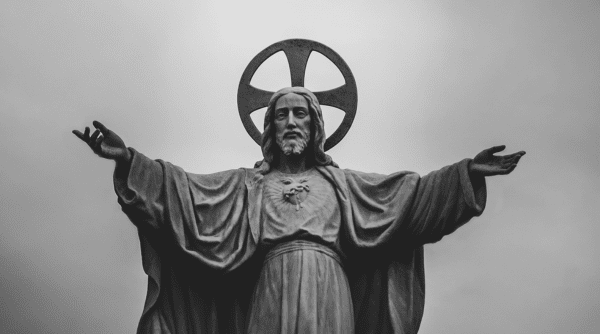The devotion to the Sacred Heart of Jesus is a powerful one that renews the hesed covenantal love between God and man. This devotion consists of five basic elements, which renew humanity by restoring our relationship with the God who loves us.
Our Lord gave these five aspects of the Sacred Heart devotion to St. Margaret Mary in four apparitions. They consist of the following:
- Thirty-Three Visits (given during an apparition on December 27, 1673)
- The image of the Sacred Heart (enthronement and badge) (July 2, 1674)
- Nine First Fridays (July 1674)
- Thursday night Holy Hour (July 1674)
- The feast of the Sacred Heart (June 1675)
Devotion to the Sacred Heart must have personal applications because God is not an egotist who needs divine consolation to feel good. God ask us to console His heart so we can rest in Him, which is what is best for us. God is thinking about us even when He is asking for consolation. This is true love! The five magnificent aspects of this devotion help repair our relationship with Christ’s Sacred Heart and lead us to love God even more. Let us look at each one.
The first aspect of the Sacred Heart devotion is thirty-three visits to the Lord. Thirty-three times during a specified time frame (daily, if possible, but especially on Fridays14), we can visit the Lord through prayer or in other people—remember, Jesus said, “Just as you did it to one of the least of these who are members of my family, you did it to me” (Matt. 25:40).
St. Margaret Mary received this revelation on December 27, 1673. Here is the apparition’s fuller context so that we can get to the heart of this aspect of devotion:
“My divine heart,” he [Jesus] told me, “is so passionately fond of the human race, and of you in particular, that it cannot keep back the pent-up flames of its burning charity any longer. They must burst out through you and reveal my heart to the world, so as to enrich mankind with my precious treasures.
Next, he asked for my heart. I begged him to take it; he did, and placed it in his own divine heart. He let me see it there—a tiny atom being completely burned up in that fiery furnace. Then, lifting it out—now a little heart-shaped flame—he put it back where he had found it. “There, my well-beloved,” I heard him saying, “that’s a precious proof of my love for you, hiding in your side a little spark from its hottest flames. That will be your heart from now on; it will burn you up — to your very last breath. . . . And how have you been describing yourself up to the present: my slave? Well, now I’m giving you a new name: the beloved disciple of my Sacred Heart.” (emphasis mine)
In this revelation to St. Margaret Mary, we see that the more someone consoles the Sacred Heart, the more beneficial it is to that person. Notice that Jesus says first and foremost, “Give me your heart.” He wants a relationship with us. Then He points out the littleness of St. Margaret Mary’s and our hearts compared with His. Our hearts may be as tiny as atoms in the plan of God, but that can still be a blessing in God’s plan to change the world. As another great mystic, St. Catherine of Siena, says, “Be who God meant you to be and you will set the world on fire.” Then notice that Jesus gives St. Margaret Mary a new heart, a new perspective on life. Finally, the relationship with Jesus is renewed. He says to her: You are not just “my slave” or my servant; you have a new name: the beloved! By consoling the heart of Jesus, we remember our primary identity, which is someone loved by God!
These benefits can be ours through the thirty-three visits to the Lord. These visits are simple yet powerful: we make visits to Jesus in the tabernacle or simply pause and say hello to Jesus thirty-three times in a day, a week, a month, or whatever the designated amount of time. The more we spend time with Jesus, the greater the benefits we receive. Namely, we receive a relationship and a new heart, inspired by the fires of divine love, to replace the cold, bored, or despairing hearts that we carry due to life’s circumstances. This devotion also reminds us to live out our identity of being loved by God. This is important because so many people today feel isolated, unloved, confused, and without purpose. St. Teresa of Calcutta calls these feelings “spiritual poverty.” She says, “Being unwanted, unloved, uncared for, forgotten by everybody, I think that is a much greater hunger, a much greater poverty than the person who has nothing to eat.” Mother Teresa then continues with a practical application of these thirty-three visits involving visiting God in the poor. These visits console the heart of Christ while uplifting individuals:
Without suffering, our work would just be social work, very good and helpful, but it would not be the work of Jesus Christ, not part of the Redemption. All the desolation of the poor people, not only their material poverty, but their spiritual destitution, must be redeemed. And we must share it, for only by being one with them can we redeem them by bringing God into their lives and bringing them to God.
Spiritual destitution must be redeemed or offered to God. And bringing it to God consoles His heart because it allows our relationship to develop unconditionally. So let us aim to visit the Lord thirty-three times either in the Blessed Sacrament, in the quiet of our hearts (so our hearts can meet His heart—cor ad cor loquitur), or in the poor, as Jesus tells us, “Just as you did it to one of the least of these who are members of my family, you did it to me” (Matt. 25:40).
+
This article on devotion to the Sacred Heart is adapted from the book Peaceful Hearts, Zealous Hearts by Deacon Gerard-Marie Anthony which is available from Sophia Institute Press.
Art for this post on a reflection from “Peaceful Hearts, Zealous Hearts” by Deacon Gerard-Marie Anthony: cover used with permission; Photo by Arturo Rey on Unsplash






